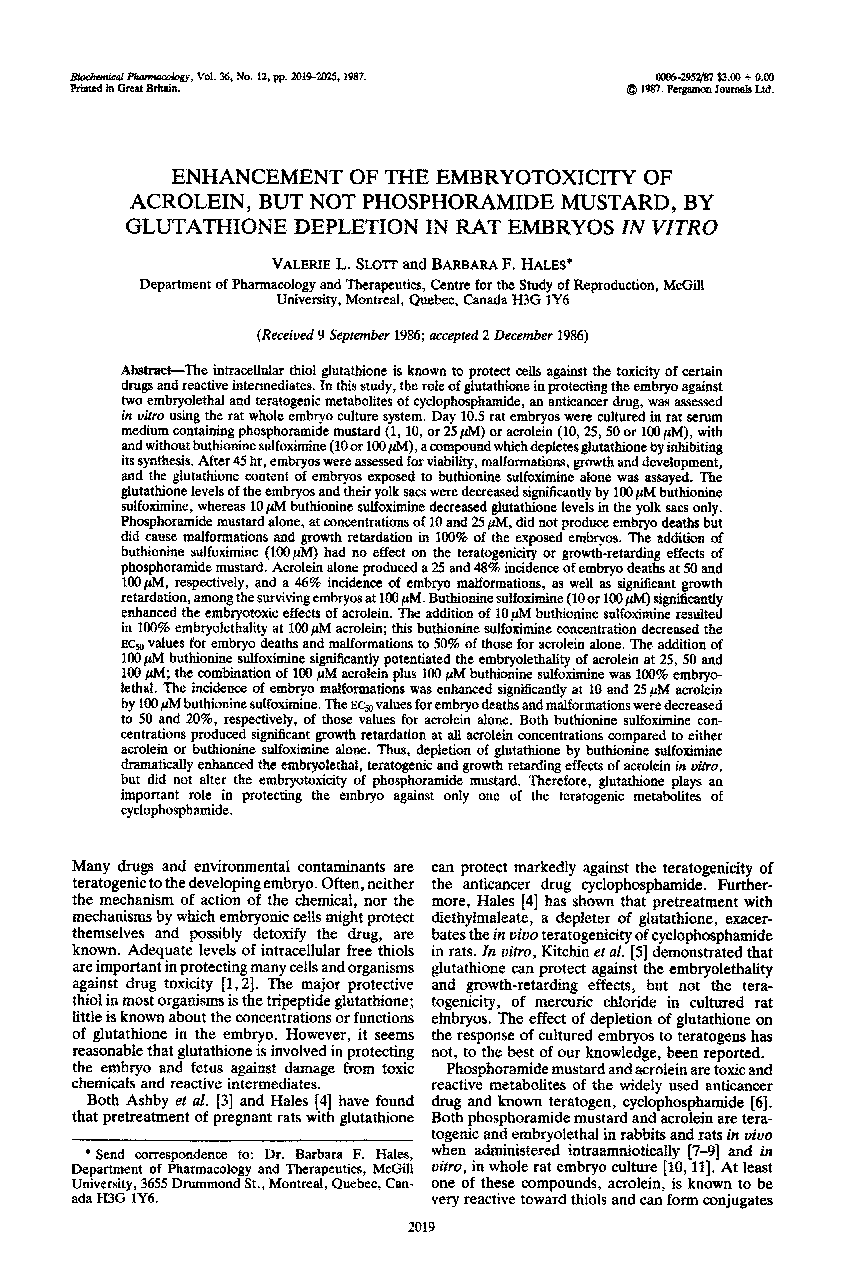| کد مقاله | کد نشریه | سال انتشار | مقاله انگلیسی | نسخه تمام متن |
|---|---|---|---|---|
| 2517572 | 1118959 | 2019 | 7 صفحه PDF | دانلود رایگان |
عنوان انگلیسی مقاله ISI
Enhancement of the embryotoxicity of acrolein, but not phosphoramide mustard, by glutathione depletion in rat embryos in vitro
ترجمه فارسی عنوان
افزایش سمیت جنین از آکرولئین، اما خردل فسفورامید، با حذف گلوتاتیون در جنین های موش در شرایط آزمایشگاهی
دانلود مقاله + سفارش ترجمه
دانلود مقاله ISI انگلیسی
رایگان برای ایرانیان
موضوعات مرتبط
علوم پزشکی و سلامت
داروسازی، سم شناسی و علوم دارویی
داروشناسی
چکیده انگلیسی
The intracellular thiol glutathione is known to protect cells against the toxicity of certain drugs and reactive intermediates. In this study, the role of glutathione in protecting the embryo against two embryolethal and teratogenic metabolites of cyclophosphamide, an anticancer drug, was assessed in vitro using the rat whole embryo culture system. Day 10.5 rat embryos were cultured in rat serum medium containing phosphoramide mustard (1, 10, or 25 μM) or acrolein (10, 25, 50 or 100 μM), with and without buthionine sulfoximine (10 or 100 μM), a compound which depletes glutathione by inhibiting its synthesis. After 45 hr, embryos were assessed for viability, malformations, growth and development, and the glutathione content of embryos exposed to buthionine sulfoximine alone was assayed. The glutathione levels of the embryos and their yolk sacs were decreased significantly by 100 μM buthionine sulfoximine, whereas 10 μM buthionine sulfoximine decreased glutathione levels in the yolk sacs only. Phosphoramide mustard alone, at concentrations of 10 and 25 μM, did not produce embryo deaths but did cause malformations and growth retardation in 100% of the exposed embryos. The addition of buthionine sulfoximine (100 μM) had no effect on the teratogenicity or growth-retarding effects of phosphoramide mustard. Acrolein alone produced a 25 and 48% incidence of embryo deaths at 50 and 100 μM, respectively, and a 46% incidence of embryo malformations, as well as significant growth retardation, among the surviving embryos at 100 μM. Buthionine sulfoximine (10 or 100 μM) significantly enhanced the embryotoxic effects of acrolein. The addition of 10 μM buthionine sulfoximine resulted in 100% embryolethality at 100 μM acrolein; this buthionine sulfoximine concentration decreased the ec50 values for embryo deaths and malformations to 50% of those for acrolein alone. The addition of 100 μM buthionine sulfoximine significantly potentiated the embryolethality of acrolein at 25, 50 and 100 μM; the combination of 100 μM acrolein plus 100 μM buthionine sulfoximine was 100% embryolethal. The incidence of embryo malformations was enhanced significantly at 10 and 25 μM acrolein by 100 μM buthionine sulfoximine. The ec50 values for embryo deaths and malformations were decreased to 50 and 20%, respectively, of those values for acrolein alone. Both buthionine sulfoximine concentrations produced significant growth retardation at all acrolein concentrations compared to either acrolein or buthionine sulfoximine alone. Thus, depletion of glutathione by buthionine sulfoximine dramatically enhanced the embryolethal, teratogenic and growth retarding effects of acrolein in vitro, but did not alter the embryotoxicity of phosphoramide mustard. Therefore, glutathione plays an important role in protecting the embryo against only one of the teratogenic metabolites of cyclophosphamide.
ناشر
Database: Elsevier - ScienceDirect (ساینس دایرکت)
Journal: Biochemical Pharmacology - Volume 36, Issue 12, 15 June 1987, Pages 2019-2025
Journal: Biochemical Pharmacology - Volume 36, Issue 12, 15 June 1987, Pages 2019-2025
نویسندگان
Valerie L. Slott, Barbara F. Hales,
